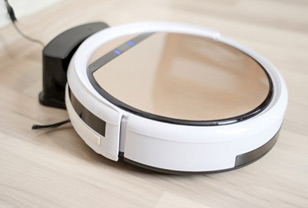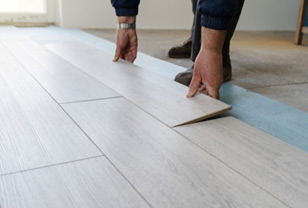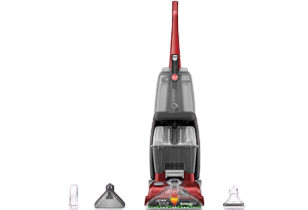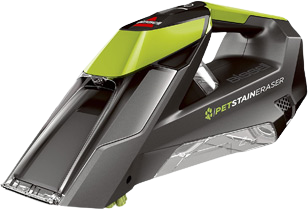How to Clean a Popcorn Ceiling: The Complete Guide
- The Best Methods for Cleaning Your Shag Rugs
- How to Install Wall-to-Wall Carpet Yourself
- How To Clean A Bathroom Fast And Efficiently
However, popcorn ceilings often hold onto dust, making them challenging to clean. Also, the texture is vulnerable to damage, and especially moisture. If you own a house with this kind of ceiling, it’s not a surprise that you have to look for help. This post will answer the question “how do you clean a popcorn ceiling”, helping you get rid of stubborn stains and give your house a refreshed appearance.
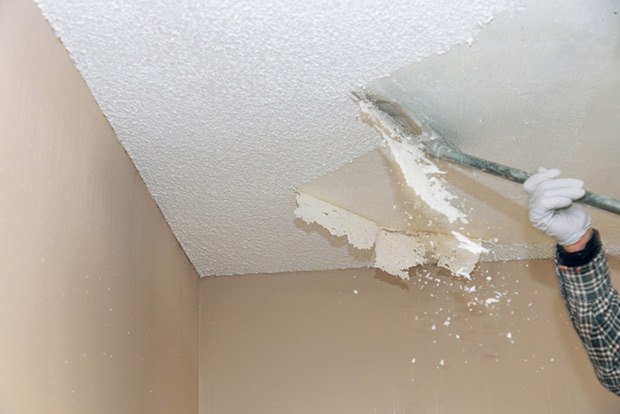
Things you need to gather for the task
☑ Plastic tarps
☑ 1 pair of goggles
☑ 1 protective mask
☑ 1 stepladder
☑ Good vacuum cleaner with brush attachments
☑ 1 feather duster
☑ 1 roll of duct tape
☑ 1 broom
☑ 1 paint roller
☑ Water
☑ Mild liquid dish soap
☑ Bleach, detergent, or vinegar
☑ Spray bottles
How to Clean a Textured Ceiling – The Ultimate Tutorial
Step 1: Carefully check the ceiling’s state

Popcorn ceilings often appear in old houses, usually those built during the 1950s or 1960s. If your home is that old, you should consider checking for the asbestos level inside the texture. Inhaling asbestos will cause lung-scarring diseases, and even cancer. The high asbestos level is the reason why many families have hired companies to remove popcorn ceilings.
Then, get to know your problem. Is the ceiling just full of dust, or does it have other troubles, like grease stains, mildew, smoke stains, water, etc.? Each one requires a specific solution. Next, apply a small amount of water to a corner to make sure it doesn’t disintegrate. If there are any hints that the ceiling will fall apart with only a little moisture, you might want to think about replacing it.
➜ RELATED: How To Clean With Vinegar - Amazing Remedies And Cleaning Hacks For Homeowners
Step 2. Remove any dust on the surface
Before taking any further action, cover your furniture with plastic tarps. If you don’t have tarps, move the furniture to another room to save yourself from having to do arduous cleaning later. Put on a pair of goggles and a protective mask. Cover your hair as well, if needed.
Check out the following steps to learn how to clean dust from a popcorn ceiling.

1. Vacuum the surface
A handheld vacuum is a great choice as long as it has a hose extension. Or you can use a cordless stick vacuum. This will save you from having to climb up and down a stepladder. You should choose a vacuum with brush attachments for better cleaning performance. It will suck up dirt and stubborn cobwebs on the texture.
➜ RELATED: Cleaning Dog Hair Out of the Carpet
2. Use a feather duster
If you don’t have a vacuum cleaner, you can resort to a feather duster. Use a pole extension so you don’t have to climb up to reach the popcorn ceiling. Note that the cleaning effect will not be as good as it would be using a vacuum. Also, the air around you will fill with dust. After dusting, remove the cobwebs that linger on the feathers.
3. Use duct tape
Sometimes, when dust gets stuck deep into the cottage-cheese-like texture, it’s impossible to remove using a duster or vacuum. This is when you need a paint roller. Wrap duct tape around it with the sticky side up. Then slowly roll the paint roller on the ceiling. It’s gentle on the texture, yet flexible enough to pick up stubborn dirt from crooks and corners. The dust will stick to the tape. Replace the tape after a few moves to get the best cleaning popcorn ceiling experience.
4. Use a broom if you can’t apply the three solutions above
Actually, a broom is not a good choice because it will make the flakes of the ceiling fall. You must use a clean broom; otherwise, the ceiling may get dirtier. Use the tool to brush the surface as gently as possible.
Step 3: Treat the more severe stains
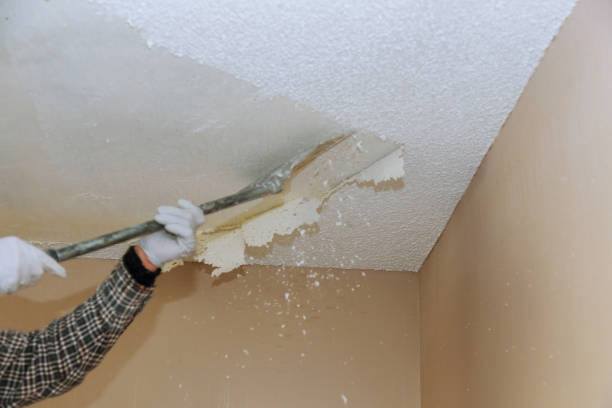
Like we mentioned above, if your ceiling has problems besides dust and cobwebs, you will need to take specific measures. Based on the difficulty level, we will introduce you to some solutions for particular stains. When treating these stains, you should wear protective gear (the mask and pair of goggles). If solutions containing soap or bleach fall into your eyes, they may cause irritation or more troublesome issues.
1. Using water only
For a light stain, you can treat it with water only. Choose a thick-nap paint roller (about 19mm thick or more) to make sure it doesn’t break the vulnerable texture. You should also pay attention to the tool’s softness. If it’s too tough, it could damage the popcorn ceiling.
Wet the roller, but make sure it’s not dripping wet. The tool should be slightly damp. Of course, the water used for cleaning a popcorn ceiling must be dirt-free, as the popcorn ceiling is probably light in color. Apply a little water to the surface to check if it could fall out due to the moisture. If things don’t go as well as planned, you must be more cautious. Ideally, you can hire a professional to deal with the problem.
If the popcorn ceiling doesn’t disintegrate, roll the dampened tool over the texture. Make straight moves in a line, and apply a thin, even coat of water. You don’t need to use too much force. When the roller gets dirty, rinse it under running water to prevent more dust spots from appearing. Before using the roller again, squeeze out the water.
➜ RELATED: 50 Amazing Cleaning Tips You'll Wish You Knew Sooner
2. Making specialized solutions for worse stains
For grease spots, which often appear on a kitchen’s ceiling, you may need some liquid dish soap. Mix a little dish soap into warm water and pour the mixture into a spray bottle. Apply a thin layer of the solution to the grease stain and lightly dab it with a clean, soft cloth. Leave the liquid to dry on the surface. Later, check for the effect and repeat the steps if needed.
For deeper stains like water drips, smoke, and mildew, a little detergent, vinegar, or bleach will work. If you want to use bleach, mix one part of bleach with five parts of water. As for vinegar or detergent, the amounts of water and of the other substance are equal. Apply the solution to the dirty spots using a paint roller. Another method is to spray the ceiling. Let the surface absorb the liquid and the stains will fade away.
➜ RELATED: How to Clean Your Room in a Fast and Fun Way
3. Repeat the cleaning for a better effect
After cleaning textured ceilings with water or specific solutions, you must let them dry naturally. Leave the window open or switch on the circulating fan. After that, check if the effect is satisfactory.
In most cases, old popcorn ceilings won’t return to their original glory after just one cleaning session. You must repeat the process several times for best results. However, do this only if you see improvement after the first try. If you don’t, cleaning any further will be a useless move.
If the surface is unrecoverable, you may think about removing popcorn ceilings or repainting them. To repaint the ceiling yourself, make sure you have gotten rid of any dust on the surface. Also, wear proper protective gear. First, coat the cleaned ceiling with an oil-based primer. It will make an excellent base to maintain the look of the new paint. Let the primer dry naturally for at least two hours. Then, cover the surface with at least two coats of acrylic flat ceiling paint.
After repainting, add cleaning the ceiling to your list of regular household chores. Don’t let new stains sit on the texture for too long if you don’t want to paint it again soon.
How Often Should We Clean Popcorn Ceilings?
Because a textured ceiling often collects dust, spider webs, and sometimes even insects, it can rapidly become dull. Do a thorough cleaning twice a year to brighten the surface and reduce allergens. If you do it more often, the texture could come loose and degrade.
Also, you should care more about corners and areas near HVAC vents. These places tend to capture more dirt. Stains from cooking grease, water, fireplaces, or cigarettes are challenging to remove. A coat of stain-blocking primer before repainting works well to prevent stubborn spots.
➜ RELATED: How To Clean A Carpet - Top 9 Cleaning Carpet Tips
The Final Thought
A popcorn ceiling could be your favorite if you love the look of the mid-20th century. It’s something from the past that we don’t want to replace if it’s recoverable. We hope these tips on how to clean popcorn ceilings will help you deal with the problem. Good luck in bringing the beautiful ceiling back to its prime!





